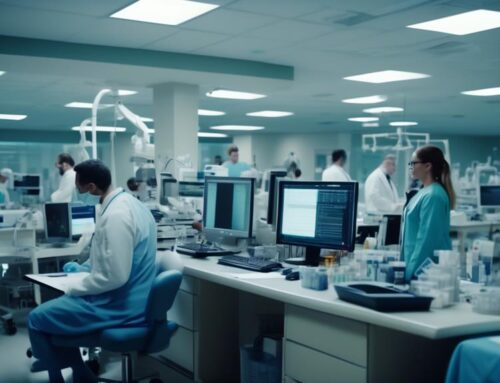Imagine a medical chart, filled with countless lines and boxes that hold the key to a patient’s well-being. This intricate web of information serves as the foundation for quality healthcare. But have you ever considered the impact of medical data entry on patient care? The truth is, the accuracy and efficiency of entering medical data can make all the difference in a person’s treatment journey. From accurate diagnoses to improved patient outcomes, the way in which medical data is entered plays a crucial role in delivering timely and effective care. But there’s more to it than meets the eye. Stay tuned to uncover the hidden ways in which medical data entry affects patient care.
Accurate Diagnoses
To ensure accurate diagnoses, it is essential to meticulously record and analyze medical data during the patient care process. This step is crucial as it directly impacts improved healthcare outcomes and patient satisfaction. Accurate diagnoses are vital because they lay the foundation for appropriate treatment plans and interventions. When medical professionals have access to comprehensive and accurate medical data, they can make informed decisions about the patient’s condition, resulting in better outcomes.
By documenting and analyzing medical data, healthcare providers can identify patterns, trends, and potential risk factors. This information allows them to make accurate diagnoses promptly and initiate timely interventions. Moreover, accurate diagnoses lead to more targeted treatment options, reducing the risk of unnecessary procedures or medications. This not only improves healthcare outcomes but also minimizes the potential for adverse reactions or complications.
Accurate diagnoses also play a significant role in patient satisfaction. When patients receive correct diagnoses, they gain a sense of trust and confidence in their healthcare provider. They feel heard and understood, which contributes to their overall satisfaction with the healthcare experience. On the other hand, incorrect or delayed diagnoses can lead to frustration, anxiety, and a loss of trust in the healthcare system.
Personalized Treatment Plans
Developing personalized treatment plans is a critical aspect of patient care that requires careful analysis of medical data. By examining the individual’s medical history, symptoms, and test results, healthcare professionals can tailor treatment strategies to meet the specific needs of each patient. Personalized treatment plans involve the implementation of individualized therapies and customized interventions that aim to optimize patient outcomes.
Through medical data entry, healthcare providers can gather and analyze relevant information, such as medication history, allergies, previous treatments, and genetic factors. This data allows them to identify patterns, risk factors, and potential interactions that may influence treatment decisions. By considering these factors, healthcare professionals can design treatment plans that are more effective and better suited to each patient’s unique circumstances.
Personalized treatment plans offer numerous advantages. They can minimize the risk of adverse reactions by avoiding medications that the patient may be allergic to or have had negative reactions to in the past. Furthermore, customized interventions can address specific underlying causes of a patient’s condition, leading to improved outcomes. By tailoring treatment plans to individual needs, healthcare providers can optimize the efficacy and safety of medical interventions.
Efficient Communication
Efficient communication is essential in the healthcare setting for effective coordination and delivery of patient care. Streamlined processes and effective collaboration through efficient communication can greatly impact patient outcomes. Here are three reasons why efficient communication is crucial in healthcare:
- Improved patient safety: Clear and timely communication among healthcare providers ensures that critical information is accurately conveyed, reducing the risk of medical errors. By sharing information efficiently, healthcare teams can make informed decisions and provide safer care to their patients.
- Enhanced care coordination: Efficient communication allows different healthcare professionals to seamlessly exchange information and coordinate care plans. This ensures that all members of the healthcare team are on the same page and can provide the best possible care for the patient. Effective collaboration leads to improved patient outcomes and a more holistic approach to healthcare.
- Time and resource optimization: By streamlining communication processes, healthcare providers can save valuable time and resources. Quick and accurate communication allows for faster decision-making, reducing delays in patient care and optimizing resource allocation.
Timely Care
To ensure timely care, the impact on treatment speed, efficiency of care, and patient outcomes improvement must be considered. By streamlining medical data entry and communication processes, healthcare providers can access critical patient information quickly and make informed decisions promptly. This not only reduces delays in treatment but also enhances the overall quality of care received by patients.
Impact on Treatment Speed
Improving the speed of treatment is a crucial aspect of effective medical data entry and patient care. By optimizing workflows and integrating technology, healthcare providers can significantly enhance the speed at which patients receive treatment. Here are three ways in which medical data entry impacts treatment speed:
- Streamlined documentation: Efficient data entry processes eliminate the need for manual paperwork, allowing healthcare providers to quickly document patient information and treatment plans.
- Real-time access to information: With integrated technology, medical professionals can access patient data instantly, enabling faster decision-making and reducing treatment delays.
- Coordinated care: Effective data entry ensures that all healthcare providers involved in a patient’s treatment have access to the same information, promoting seamless communication and collaboration, ultimately leading to faster treatment.
Efficiency of Care
By optimizing workflows and integrating technology to enhance the speed at which patients receive treatment, medical data entry plays a crucial role in ensuring timely and efficient care. Efficient care involves minimizing delays in providing medical attention, which can lead to improved patient outcomes and satisfaction. Through streamlined data entry processes and the use of electronic health records (EHRs), healthcare providers can access patient information quickly and accurately. This enables them to make informed decisions promptly, reducing the time patients spend waiting for care. Additionally, efficient data entry contributes to cost reduction by minimizing administrative burdens, allowing healthcare professionals to focus more on patient care. Workflow optimization, facilitated by effective medical data entry, is essential for ensuring that patients receive timely and efficient care.
Patient Outcomes Improvement
Efficient medical data entry ensures that patients receive timely and effective care, leading to improved outcomes. By accurately documenting patient information, healthcare providers can make informed decisions and take prompt actions, resulting in better patient outcomes. Here are three ways that efficient medical data entry can positively impact patient outcomes:
- Timely diagnosis and treatment: Access to up-to-date medical records enables healthcare providers to quickly identify and address patients’ health issues, leading to timely diagnosis and treatment. This reduces the risk of complications and improves patient outcomes.
- Improved coordination of care: Efficient data entry allows for seamless communication and coordination among healthcare teams, ensuring that patients receive the right care at the right time. This collaborative approach enhances patient satisfaction and reduces medical errors.
- Cost reduction: Accurate data entry facilitates appropriate resource allocation, minimizing unnecessary tests, procedures, and hospital stays. This leads to cost reduction and improved healthcare affordability for patients.
Improved Patient Outcomes
To enhance patient outcomes, accurate and timely medical data entry is crucial. By ensuring that medical data is entered accurately and promptly, healthcare providers can contribute to better prognoses and enhanced recovery for their patients.
Accurate medical data entry allows healthcare professionals to have a comprehensive and up-to-date view of a patient’s medical history, symptoms, and treatment plans. This information is vital in making informed decisions about diagnosis, treatment options, and ongoing care. With accurate data entry, healthcare providers can identify patterns, detect potential complications, and tailor treatment plans to meet individual patient needs.
Timely medical data entry also plays a significant role in improving patient outcomes. When medical data is entered promptly, it allows healthcare providers to access critical information quickly, leading to faster interventions and improved patient care. For example, in emergency situations, quick access to accurate medical data can help healthcare providers make informed decisions and initiate life-saving treatments promptly.
Moreover, accurate and timely medical data entry enables effective communication and collaboration among healthcare providers. When medical data is consistently and accurately recorded, it facilitates seamless transitions of care, reduces medical errors, and ensures that all healthcare professionals involved in a patient’s care have access to the same information.
Reduced Medical Errors
To reduce medical errors, you must implement error prevention measures such as double-checking data entry and using electronic systems that flag potential mistakes. By doing so, patient safety is enhanced as errors are caught before they can harm the patient. Additionally, improved accuracy in treatment plans and medication administration ensures that patients receive the appropriate care, minimizing the risk of adverse events.
Error Prevention Measures
Implementing error prevention measures is crucial in reducing medical errors and improving patient care. By utilizing error detection and data validation techniques, healthcare providers can enhance the accuracy and integrity of medical data entry. Here are three key measures that can help achieve this goal:
- Real-time error alerts: Implementing systems that can detect errors as they occur, such as missing or inconsistent data, can prompt immediate correction and prevent potential harm to patients.
- Automated data validation: Utilizing automated software solutions that check for data discrepancies and validate entries against predetermined rules can significantly reduce the occurrence of errors and ensure the accuracy of medical records.
- User-friendly interfaces: Providing healthcare professionals with intuitive and easy-to-use data entry interfaces can minimize human errors, improve efficiency, and enhance the overall quality of patient care.
Enhanced Patient Safety
By implementing error prevention measures, healthcare providers can enhance patient safety by reducing medical errors. One important aspect of enhanced patient safety is improved patient monitoring. Accurate and up-to-date medical data entry allows healthcare providers to monitor patients more effectively, ensuring that they receive the appropriate care and treatment. With the right information at their fingertips, healthcare professionals can make informed decisions in a timely manner, minimizing the risk of medical errors and improving patient outcomes. Additionally, data security plays a crucial role in patient safety. Robust security measures protect patient data from unauthorized access or breaches, reducing the risk of identity theft or medical fraud. By prioritizing patient monitoring and data security, healthcare providers can create a safer and more secure environment for patients, fostering trust and improving overall healthcare quality.
Improved Treatment Accuracy
Improved treatment accuracy is crucial in reducing medical errors and ensuring optimal patient care. By improving treatment accuracy, healthcare providers can achieve better treatment outcomes and increased healthcare efficiency. Here are three key reasons why improved treatment accuracy is essential:
- Enhanced patient safety: Accurate data entry helps avoid medication errors, misdiagnosis, and incorrect treatment plans, reducing the risk of harm to patients.
- More effective treatment: Accurate documentation allows healthcare providers to make informed decisions, leading to more precise and appropriate treatment strategies, resulting in improved patient outcomes.
- Increased healthcare efficiency: Accurate data entry streamlines communication and coordination among healthcare professionals, reducing delays and ensuring timely access to critical information, ultimately improving the efficiency of the healthcare system.
Frequently Asked Questions
How Does Medical Data Entry Affect Patient Privacy and Confidentiality?
When you consider patient trust and the potential for a data breach, it’s crucial to recognize how medical data entry affects patient privacy and confidentiality.
What Are the Potential Challenges and Barriers in Implementing Accurate Medical Data Entry?
Accuracy challenges and technological barriers are potential challenges in implementing accurate medical data entry. Ensuring data entry is error-free and overcoming technical limitations are crucial for effective patient care.
How Can Medical Data Entry Contribute to the Overall Cost-Effectiveness of Healthcare?
When you accurately enter medical data, you contribute to cost savings and improved outcomes in healthcare. By ensuring precise and timely information, medical decisions can be made more efficiently, leading to better patient care.
Are There Any Specific Training or Educational Requirements for Healthcare Professionals Regarding Medical Data Entry?
Healthcare professionals must undergo specific training and meet educational requirements to ensure proficiency in medical data entry. This ensures accurate and efficient data recording, which is crucial for effective patient care.
How Does Medical Data Entry Impact the Workflow and Efficiency of Healthcare Providers?
Medical data entry impacts the workflow and efficiency of healthcare providers by optimizing workflows, ensuring data accuracy and integrity. Providers can save time and improve patient care by efficiently entering and accessing vital medical information.




